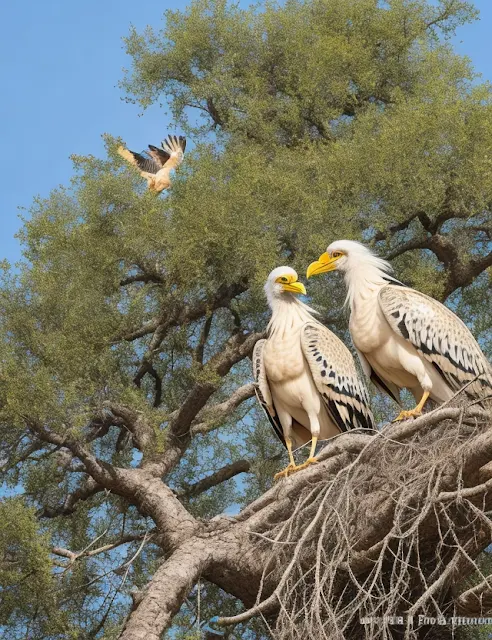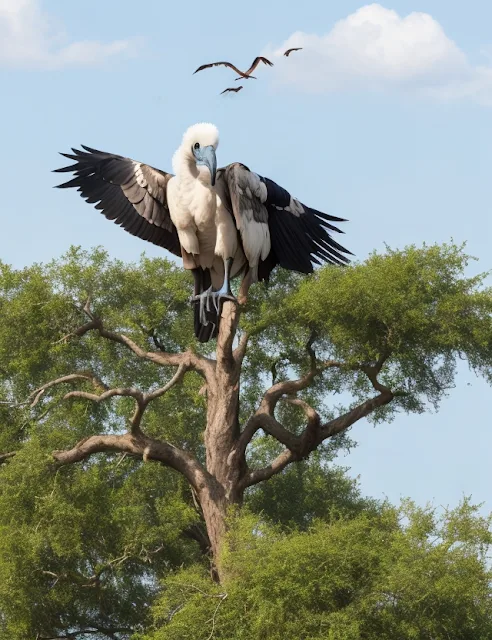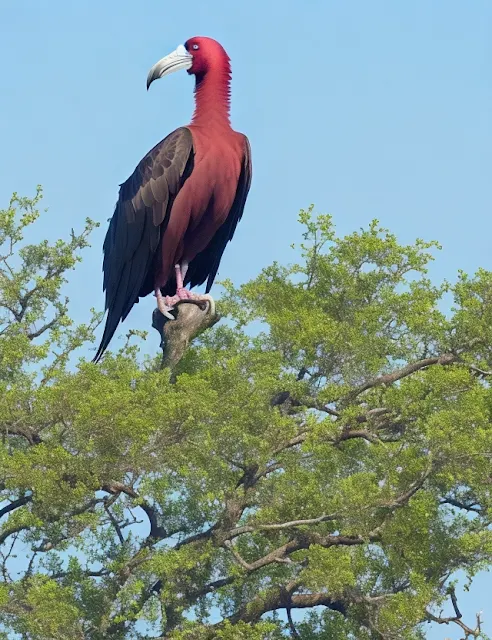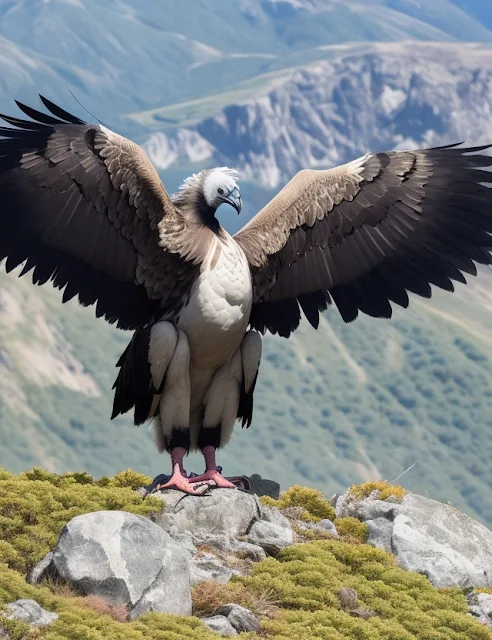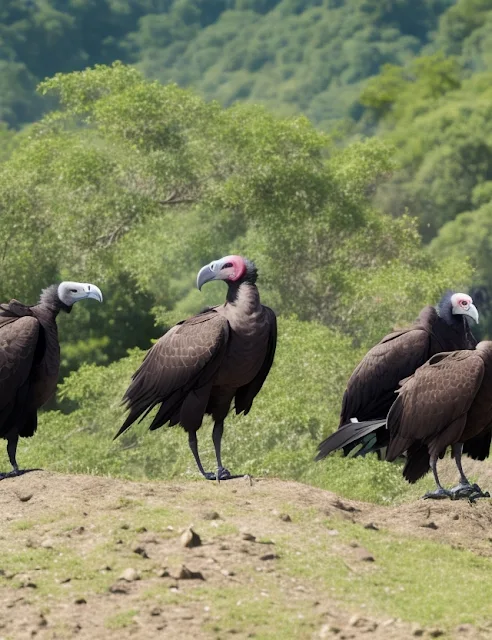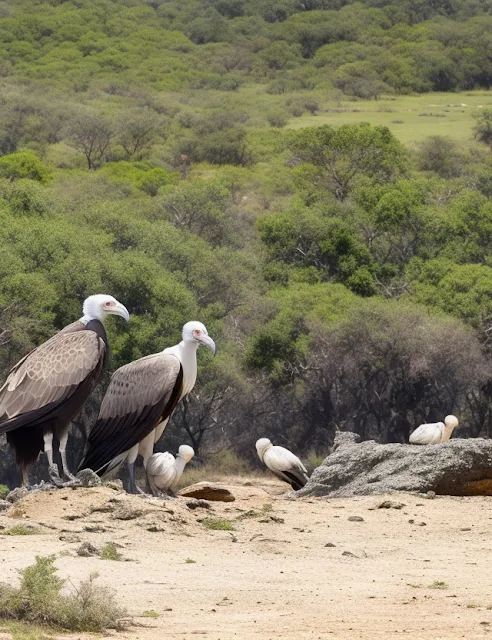How many species of Vulture? The part two
Vulture(2/3)
The Egyptian vulture
The Egyptian vulture is a species of Old World vulture native to Africa, Asia, and Europe. It is one of the most widespread raptors in the world, with populations found across much of its range. This small scavenger has an impressive wingspan that can reach up to 5 feet in length and they typically weigh between 2-3 pounds when fully grown.
The Egyptian Vulture's diet consists mainly of carrion but it will also feed on eggs, chicks, reptiles, and small mammals if necessary. They are known for their intelligence as well as their ability to use tools such as stones or sticks for food procurement purposes - a trait not seen amongst other avian species!
Egyptian vultures have been around since ancient times; they were even featured prominently in hieroglyphics from Ancient Egypt! These birds were highly revered by many cultures due to their association with death (they would often be seen feeding on carcasses) but also because they could symbolize rebirth through their migratory patterns – travelling great distances each year between different continents during breeding season before returning home again afterwards.
The Egyptian Vulture today faces threats from habitat loss due to human activities like land development or agricultural expansion which destroys nesting sites & reduces available food sources; illegal poaching & hunting; electrocution caused by powerlines & wind turbines; climate change which affects migration routes/patterns etc...
Thankfully though conservation efforts are being made throughout its range including captive breeding programs aimed at increasing numbers where possible plus education initiatives designed raise awareness about this beautiful bird’s plight so hopefully we can help ensure its future survival long into the next century!
The Indian vulture
The Indian vulture is a species of large raptor native to the Indian subcontinent. It is one of the most important scavengers in India, helping keep its environment clean by feeding on carrion and other dead animals.
The bird has suffered from significant population declines due to human activities such as habitat destruction and poisoning from veterinary drugs which have been used as livestock treatments. This has caused a dramatic decrease in their numbers, leading them to be listed as critically endangered by the IUCN Red List since 2002.
The birds are highly social creatures that form large flocks when foraging or roosting together at night time, making them an iconic symbol of India’s wildlife diversity and natural beauty. They can often be seen soaring high above fields searching for food or perched atop trees looking out over their surroundings with keen eyesight – they are even able to spot prey up to two kilometers away!
Despite being so easy recognizable though sadly these majestic birds have become increasingly rare due largely thanks human-induced threats like poaching and use of pesticides which poison both animal carcasses that make up much their diet along with water sources where they drink during hot days .
Fortunately conservation efforts are underway across India aiming not only protect but also increase populations this species through captive breeding programs reintroduction into wild areas protected zones educational campaigns public awareness initiatives help reduce illegal hunting practices .
Additionally research conducted better understand ecology behavior life history reproductive habits migratory patterns all play vital role ensuring long term survival success these incredible avian creatures so future generations may continue enjoy sight sound presence graceful fliers our skies once again .
The white-backed vulture
The white-backed vulture is a large species of Old World vulture that can be found in parts of Africa, Asia, and the Middle East. It has an impressive wingspan of up to 2 meters wide and is easily recognizable by its distinctive black plumage with white patches on its back.
This species plays an important role in their ecosystems as scavengers; they feed mainly on carrion from dead animals which helps keep the environment clean.
White-backed vultures have been decreasing rapidly due to several factors such as habitat loss, hunting for traditional medicine or food purposes, poisoning from animal carcasses containing chemicals used in agriculture practices and even electrocution when they land on power lines while searching for food sources.
As a result populations are facing serious threats with some subspecies being listed as critically endangered according to IUCN Red List assessments conducted between 2014 - 2019. Conservation efforts need to be taken seriously if we want this majestic bird population remain stable into future generations so that these birds continue playing their vital role within our ecosystems!
In order to ensure the survival of White-backed Vultures it’s essential that governments implement laws protecting them against illegal hunting activities while also providing safe habitats away from human development where these birds can nest undisturbed .
Additionally more research needs done regarding potential toxins present within animal carcasses so appropriate measures can be taken ensuring no further harm comes upon these creatures due ingestion or contact with contaminated substances . Finally raising awareness about this issue among local communities will help bring attention towards conservation efforts helping protect not only White Backed Vultures but other threatened wildlife around us too!
The Red-headed Vulture
The Red-headed Vulture is one of the most majestic birds found in India. It has a distinctive red head and neck, which make it easily recognizable. This species of vulture can be found throughout the country, but its numbers are declining due to habitat destruction and hunting for traditional medicine. As such, this species is listed as endangered on the IUCN Red List of Threatened Species.
Red-headed vultures feed mainly on carrion; they scavenge carcasses left by other animals or humans rather than hunt live prey like some raptors do. They also have an impressive wingspan that allows them to soar high up in search for food sources from great distances away; their eyesight is so sharp that they can detect movement from more than two miles away! Their diet consists mostly of small mammals and reptiles, although sometimes they will eat eggs or insects if available too.
The conservation status of this bird has been a cause for concern over recent years due to various threats posed by human activities such as deforestation and hunting pressure placed upon them by local communities who use their parts for medicinal purposes or even just simply view them as pests because they often raid crops looking for food sources when there are none available elsewhere nearby...
Fortunately though many organizations have taken steps towards protecting these magnificent creatures with laws being put into place prohibiting any form illegal activity related to poaching or killing these birds without permission granted firstly through proper channels before taking action against any individual doing so - thus hopefully ensuring future generations get chance appreciate beauty gracefulness offered us all thanks presence within our environment today!
Overall, while there may be challenges facing populations around India's countryside areas where red-headed vultures reside currently – it’s important remember we still able take positive steps ensure survival long term future generations continue enjoy sight soaring above horizon skies above us clear blue sky days come again soon enough time passes bye...
Rüppell's vulture
Rüppell's vulture is a large species of Old World vulture that can be found in parts of Africa and the Middle East. It is one of the most impressive raptors due to its size and wingspan, which can reach up to 3 meters long. This bird has several unique features that make it stand out from other birds in its family.
The Rüppell's vulture has an unmistakable appearance with white feathers on its head, neck, chest, and wings which contrast against dark brown body feathers. Its bill is also blackish-brown while their feet are yellowish-white or greyish-green depending on age and sex differences between individuals.
The tail feathers have a unique patterning as well with alternating bands of light gray/white tipped with black stripes along them giving this species quite an eye catching look when seen soaring through the sky!
This majestic creature feeds mainly on carrion but will occasionally take live prey such as rodents or small reptiles if available near by for sustenance purposes too; they are often observed foraging together in groups where each individual takes turns scavenging food sources around them before returning back home again afterwards!
They’re also known to use thermal currents created by warm air rising off open plains during flight so they don't have expend much energy flapping their wings while searching for meals either - making these birds incredibly efficient hunters despite being scavengers at heart! Overall Ruppel’s Vultures really do prove how nature always finds ways adapt no matter what environment it lives within; something we could all learn from today too I believe!
The Hooded Vulture
The Hooded Vulture is a species of Old World vulture that can be found throughout much of Africa. It is characterized by its black plumage and white head, which gives it the striking appearance for which it is named. This bird feeds mainly on carrion, but will also occasionally hunt small animals or scavenge food from other sources.
Due to their reliance on carrion as a primary source of nutrition, they are often seen in areas where there has been recent death or injury among large mammals such as antelope or zebra.
Hooded Vultures have an important role in African ecology due to their ability to quickly clean up animal carcasses before diseases like anthrax can spread through the environment and affect other species. They also provide vital nutrients back into the soil when they defecate while feeding on carcasses; this helps keep grasslands healthy and prevents desertification from occurring too rapidly in certain areas with limited rainfall amounts each year.
Because these birds rely so heavily upon dead animals for sustenance, populations may decline if hunting practices become more widespread across Africa’s savannas and woodlands over time; however conservation efforts are helping ensure that Hooded Vultures remain plentiful enough for future generations to enjoy observing them soaring above African skies!
Overall, Hooded Vultures play an essential role within many African ecosystems by providing nutrient-rich fertilizer back into soils while simultaneously preventing disease outbreaks from spreading too far out amongst local wildlife populations—all without having any direct negative impact upon human beings whatsoever!
These birds truly embody what nature intended: balance between predator & prey without taking away resources needed by either side at any given time—a feat not easily achieved yet still tremendously appreciated all around our world today!
The Himalayan Vulture
The Himalayan Vulture is a majestic bird found in the Himalayas and other mountain ranges throughout South Asia. It is an impressive species, with large wingspan of up to 7 feet and a striking white head. The vultures are scavengers that feed on carrion, but they also hunt for small mammals such as hares or rodents when food is scarce.
They usually live in groups of four to five individuals, though larger flocks can be seen during the winter months when food availability increases.
Himalayan Vultures have been studied extensively by ornithologists due to their unique adaptations for life at high altitudes where oxygen levels are low and temperatures range from freezing cold at night to very hot during the day.
These birds have specially adapted feathers which help them keep warm while flying over snow-capped peaks or glaciers; they also possess powerful talons which allow them to grab onto rocks while soaring through windswept valleys between mountainsides without losing altitude too quickly!
In recent years there has been concern about declining numbers of these magnificent creatures due mainly habitat destruction caused by humans who build roads or construct buildings closeby their nesting sites; this makes it difficult for vultures find enough food sources nearby as well as safe places where they can breed successfully each year without disturbance from human activity.. Conservation efforts must continue if we want future generations enjoy watching these amazing birds soar gracefully above our heads!
The Lappet-faced Vulture
The Lappet-faced Vulture is a large bird of prey native to Africa and the Middle East. It has an impressive wingspan, reaching up to 8 feet in length, and its distinctive facial features give it a unique look among vultures.
The Lappet-faced Vulture is an important part of the African ecosystem as it helps keep animal populations healthy by scavenging for dead animals that would otherwise go to waste.
The diet of the Lappet-faced Vulture mainly consists of carrion, which they find by soaring high above their habitat looking for food sources on the ground below them. They are also known to hunt small mammals such as rodents or hares if there isn’t enough carrion available in their area.
While they will sometimes steal kills from other predators like lions or hyenas, this behavior doesn’t occur often since these birds generally prefer not to compete with larger animals over food sources due to their relatively weak talons and beaks compared with those species'.
Unfortunately, despite being so important for maintaining balance within ecosystems across Africa and beyond, the population numbers have been declining drastically since 1980s due largely human activities like poaching.
In order protect these majestic creatures from extinction, it’s crucial that we make efforts towards conserving our natural environment. By preserving habitats where lappets can live safely without interference from us humans, we can ensure that future generations get chance enjoy watching these beautiful birds soar through skies just we do today.
The White-rumped Vulture
The White-rumped Vulture is a large bird of prey found in India, Pakistan and other parts of South Asia. It is one of the most common vultures in the region and plays an important role in maintaining ecological balance by scavenging on dead animals. The White-rumped Vulture has a white head with dark eyes, beak and feet. Its wingspan can reach up to two meters wide when fully stretched out!
This species was once abundant throughout its range but unfortunately due to overuse of diclofenac drugs as livestock treatment it has suffered dramatic population declines since early 2000s leading them towards extinction.
Diclofenac poisoning causes kidney failure which leads to death within few days after ingestion so this drug had lethal effects on these birds resulting into their rapid decline from millions down to thousands now making them critically endangered species today!
Conservation efforts are being made for saving this species from becoming extinct such as banning use or sale any kind veterinary drugs containing diclofenac , captive breeding programs for releasing young ones back into wild etc .
Similarly public awareness campaigns are also conducted regarding importance & conservation status about these vultures so that people could understand how vital they are for our environment & why we should save them before its too late !

